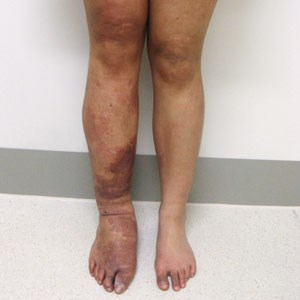 Known as Klippel-Trenaunay syndrome (KTS) and sometimes angioosteohypertrophy syndrome and hemangiectatic hypertrophy,
Known as Klippel-Trenaunay syndrome (KTS) and sometimes angioosteohypertrophy syndrome and hemangiectatic hypertrophy,
A rare congenital medical condition in which blood vessels and/or lymph vessels fail to form properly.
At least five mutations in the PIK3CA gene have been found to cause Klippel-Trenaunay syndrome.
The three main features are port-wine stain, venous and lymphatic malformations, and soft-tissue hypertrophy of the affected limb.
Clinically manifests as one or more distinctive port-wine stains with sharp borders, varicose veins, and hypertrophy of bony and soft tissues, that may lead to local gigantism or shrinking.
Associated with an improperly developed lymph system, and can either affect blood vessels, lymph vessels, or both.
Rarely, port-wine stains may be absent.
With venous involvement pain and other complications, symptoms occur.
With large AVMs thromboembolic complications may occur, as well as high-output heart failure.
Affects men and women equally, without racial preference.
May be associated with a translocation at t(8;14)(q22.3;q13).
No cure and treatment is individualized.
Surgical debulking was the most widely used treatment for the syndrome, but is presently a last resort.
Mayo Clinic has reported the largest experience in managing patients with major surgery, and only 57.5% could be treated by primary surgery.
Surgical procedures include: excision of vascular malformation, debulking operations and correction of bone deformity and limb length correction.
Surgical procedures demonstrate high recurrence rate, deformities, nerve injuries, and amputation, so that debulkation does not provide long-term benefit.
Can result in major deformities and have a high potential for recurrence and nerve injuries.
Sclerotherapy is a treatment for specific veins and vascular malformations in the affected area.
Compression therapies are increasingly used.
With this syndrome blood flow and/or lymph flow may be impeded, and fluid pools in the affected area, resulting in pain, swelling, inflammations, ulceration and infection.
Compression garments can help alleviate most of these problems, and when combined with elevation of the affected area can result in a satisfactory result without surgery.
Compression garments are also used after a debulking procedure to maintain the results of the procedure.
In infants and toddlers custom compression garments are impractical because of growth.
